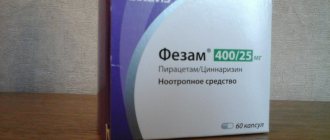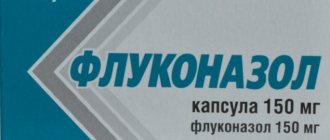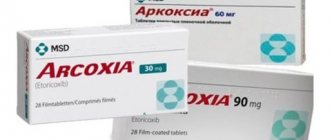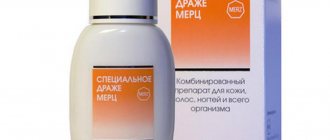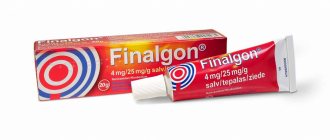The action of nootropic drugs is aimed at improving cognitive abilities and brain functioning in general. Cereton belongs to this group of drugs. The drug provides metabolic protection and promotes the release of choline. This allows you to improve concentration, memory, and improve learning abilities. Against the background of the drug’s action, restoration processes are launched during the development of various pathologies.
Release form and composition
Cereton is produced in the form of gelatin capsules and solution for injection. The active substance in the drug is choline alfoscerate. Its content in capsules is 400 mg, in ampoules of 4 ml – 1000 mg.
The capsules are oval in shape and yellowish-brown in color. They are filled with an oily liquid. Auxiliary components used in the manufacture of capsules are glycerol and purified water. The capsule shell is made on the basis of gelatin using other additional components that allow it to be given the desired shape.
Pharmacy analogues
Cereton has several analogues:
- Cerepro is an inexpensive domestic substitute that significantly improves brain activity and reduces cholinergic activity.
- Cholitin is a cholinomimetic that is available in tablets. The dosage is 400 mg of choline alfoscerate. This drug improves transmission in cholinergic neurons by properly affecting the functions of the receptors.
- Alphacholine is a substance completely identical to ceretone. This is a solution that is suitable for intravenous and intramuscular administration.
- Alzmerate is prescribed for various brain injuries, senile mental activity, and cognitive disorders.
- Neurolitin - available in ampoules, contraindicated for pregnant and lactating women.
- Gliatilin is a foreign analogue that is prescribed for unstable emotional background. Sold in solutions and capsules.
- Delecite is an Italian drug that is available in capsules and injections.
Impact
Cereton, the instructions for use indicate this, has a pronounced cholinomimetic effect. The drug promotes the release of choline in the brain. It is an important nutrient that improves cognitive performance and helps restore brain structures after severe damage.
When taking the drug, blood flow improves and metabolic processes accelerate, which minimizes the risks of developing various pathologies, including those associated with age. Cereton also normalizes brain activity and improves behavioral reactions in the presence of vascular diseases.
Alpha GPC from MR.LT
The drug significantly enhances the process of acetylcholine production. The consequence of taking it is a noticeable improvement in mental state and cognitive functions necessary for leading a full life. This drug is prescribed for depression, to improve mood, memory, and also for athletes.
Alpha GPC is a supplement that has a nootropic effect on the human body. He acts as Choline. It is a precursor to the natural neurotransmitter acetylcholine. The content of such a substance in the human body guarantees the normal functioning of speech, memory, and attention. This drug enhances the process of brain production of acetylcholine, thereby improving mental state.
Alpha GPC
1999 rub.
Alpha GPC eliminates apathy, depression, helps overcome chronic fatigue syndrome, improves mood and eliminates irritability.
When is Cereton prescribed?
Cereton, the instructions for use indicate this, is prescribed for traumatic brain injuries, ischemic and hemorrhagic strokes. The medicine is indicated to relieve acute manifestations. It is also effective during periods of recovery after severe pathological conditions, which are caused by the presence of symptoms indicating damage to the brain stem
Also, cereton, the instructions focus on this, is effective for psycho-organic syndrome. This pathology is accompanied by pronounced symptoms caused by degenerative changes in the brain. The disease can occur at any age, but most often it is provoked by atrophic processes in the brain of older people.
Nootropic medicine is considered effective for the manifestation of cognitive disorders, such as:
- Problems with logical thinking.
- Memory impairment.
- Appearance of confusion.
- Lack of initiative and motivation.
- Loss of concentration.
In old age, the drug is indicated for stabilizing the condition of people with the development of dementia, encephalopathy, and pseudomelancholia.
Terms of use
Cereton injections are prescribed for acute conditions. In this case, deep intramuscular injection is performed. The solution can also be administered intravenously. Therapeutic dose is 1 ampoule, which corresponds to 1000 mg of the active substance. Duration of use is 10-15 days. Thus, the price of the medicine for one course is quite high.
Cereton tablets are mainly used during the recovery period after traumatic brain injuries and strokes. The duration of treatment with the drug is 6 months. Recommended dose of medication:
- In the morning, 2 capsules, which corresponds to 800 mg.
- During the day, 1 capsule, which corresponds to 400 g of active substance.
For symptoms of dementia and confirmation of circulatory problems in the brain, it is recommended to take 1 capsule three times a day. Treatment lasts 3-6 months.
Vasodilator drugs prescribed for osteochondrosis
The work of the muscles of the vascular highways is constantly regulated by nerve impulses passing through sympathetic fibers. These signals are responsible for the muscular activity of almost all internal organs and related functions.
Eliminating stagnation of blood fluid and improving microcirculation in the pathological area makes it possible to normalize metabolic processes and restore the patency of nerve impulses, as a result of which the treatment of osteochondrosis is more effective and the patient’s health condition is stabilized.
Features of the pathogenesis of osteochondrosis disease
Nowadays, osteochondrosis disease (age-related degenerative changes in intervertebral discs) is quite common among the population. This is due to a sedentary lifestyle or, on the contrary, excessively hard physical labor, back injuries, bad habits, poor diet and inadequate sleep.
Initially, the symptoms of osteochondrosis manifest themselves as minor discomfort in the back after physical activity, limited mobility, then pain syndromes become more intense and become chronic. Destructive processes in the intervertebral discs (dehydration and insufficient supply of nutrients) provoke inflammation and swelling of the pathological area (decreased blood circulation in it). The body’s protective reaction to irritation becomes even greater muscle stiffness and pain.
Soft tissue spasms compress sympathetic nerve endings and fibers, the transmission of impulses weakens, the muscle walls of blood vessels do not receive the necessary information and also find themselves in a compressed state. Poor circulation over time leads to oxygen starvation (hypoxia).
Complex conservative treatment of the spine, as a rule, includes taking vasodilating drugs. Results of action of pharmacological agents of the vasodilator group:
- normalization of blood circulation in the pathological area and throughout the body;
- improving the nutrition of soft tissues, saturating them with fluid, accelerating metabolic processes;
- reduction of inflammation and swelling of tissues, congestion and, consequently, pain;
- restoration of the passage of nerve impulses through the fibers.
Mechanisms of drug action
The group of vasodilator drugs used to treat osteochondrosis of the joints is conventionally divided into subgroups:
- substances with myotropic effects that directly affect the muscles of the vascular walls, changing their metabolic processes and reducing tone (caffeine, papaverine, no-spa);
- drugs with neurotropic effects achieve a vasodilating effect through nervous regulation of the tone of blood vessels;
- centrally acting drugs that affect the functioning of the vasomotor center located in the brain (aminazine, apessin);
- peripheral substances:
- blocking vascular adrenergic receptors (phentolamine);
- blocking the transmission of impulses (excitation) from the nerve endings of the sympathetic branches innervating the corresponding blood lines (ornid, octadin);
- improving the transmission of impulses from parasympathetic endings to blood vessels (acetylcholine, carbacholine);
- complicating the transmission of impulses in sympathetic nerve clusters, thereby reducing vascular tone (pentamine, tetamone);
- drugs with a mixed mechanism of action - central neurotropic and peripheral myotropic (nitroglycerin, amyl nitrite, reserpine, the latter weakens the sensitivity of central and peripheral adrenergic receptors responsible for the innervation of blood vessels, expands their lumen, and also lowers blood pressure).
List of main drugs prescribed for osteochondrosis
Actovegin. It has not so much vasodilating properties as stimulating tissue regeneration. It contains many nutrients: amino acids, saccharides, nucleosides. It has a positive effect on the transport, absorption and utilization of glucose and oxygen molecules, and stabilizes the plasma membranes of cells. Restores blood flow in peripheral systems, normalizes and stimulates nutrient metabolism throughout the body, develops and regenerates collaterals (small branches of blood vessels formed during compression or thrombosis of the main channel).
Eufillin. A bronchodilator, it helps relax the muscles of the bronchi, relieves spasms, dilates blood vessels, which makes it indispensable for patients suffering from asthma. Significantly improves blood circulation in the brain and peripheral vessels, and is used to treat diseases of the spine and neurological pathologies. Stimulates the action of the respiratory centers, increases the frequency and intensity of heart contractions, which makes it unsafe for patients with acute heart failure, angina pectoris and cardiac arrhythmias. Can be used for external use in the form of electrophoresis to improve blood microcirculation in pathological areas and restore trophic processes in intervertebral discs.
Pentoxifylline or trental. Improves microcirculation and regenerating properties of blood, thins the blood, reduces total peripheral vascular resistance, dilates the coronary arteries, which accelerates the transport of oxygen throughout the body. By expanding the blood vessels of the lungs, it significantly increases the tone of the muscle fibers responsible for breathing (diaphragm and intercostal muscles). Strengthens collateral blood circulation, increases the concentration of ATP in the brain, and has a beneficial effect on the bioelectrical functions of the central nervous system. The drug is contraindicated in patients with chronically low blood pressure, atherosclerosis and arrhythmia.
Xanthinol nicotinate. Improves cerebral circulation, peripheral (collateral) microcirculation, reduces the manifestations of cerebral hypoxia (insufficient oxygen supply to the brain), normalizes and improves metabolic (metabolic) processes in the brain. Thins the blood and has a beneficial effect on the functioning of the heart.
Thioctic acid, lipoic acid or berlithion. The drug is from a group of vitamin-like substances, similar to those produced by the body, and is close in biochemical properties to vitamin B group. Participates in the regulation of lipid (fat) and carbohydrate metabolism, prevents the deposition of glucose on the walls of blood vessels, improves blood flow and lowers blood viscosity. It has detoxifying properties and has a positive effect on the functions of peripheral nerves and neurovascular bundles innervating internal organs.
Medicines prescribed for cervical osteochondrosis
Symptoms of cervical osteochondrosis primarily affect the blood supply to the brain, the condition of the vertebral arteries, the vertebrobasilar circle, and then can affect the vessels and nerve endings innervating the upper limbs. They are manifested by dizziness, headaches, nausea, coordination disorders, general weakness and fatigue, disturbances in the functioning of the organs of hearing, vision, speech, and smell.
Treatment of cervical osteochondrosis quite often includes nootropic drugs (for example, piracetam, nootropil, vinpocetine), which improve blood circulation in the vessels of the head and improve metabolic processes (carbohydrate and protein) in the brain. They do not always have pronounced vasodilating properties, but they have a beneficial effect on the central nervous system, improve memory, attention, and increase productivity.
Piracetam. It has a positive effect on metabolic reactions in the body, improves blood circulation in the brain, and restores nerve cells. The drug increases energy potential through accelerated ATP metabolism, has a beneficial effect on the central nervous system and is prescribed for diseases of the blood vessels that wash the cerebral cortex.
Vinpocetine. A vasodilator, antihypoxic agent, helps to increase cerebral circulation, especially in ischemic areas by relaxing the smooth muscles of the walls of cerebral vessels. Improves oxygen transport, reduces platelet aggregation and thereby thins blood viscosity.
It is necessary to treat osteochondrosis with complex measures: medications (which, as prescribed by a doctor, may include vasodilators), physiotherapy and physical activity.
The main thing is not to endure the pain, not to delay time, but to contact osteochondrosis treatment clinics in a timely manner. Author: K.M.N., Academician of the Russian Academy of Medical Sciences M.A. Bobyr
Contraindications and negative reactions of the body
The main contraindications to taking the drug are hypersensitivity to the active ingredient and other components. The medicine is not prescribed before reaching the age of 18 years, as well as during pregnancy and lactation.
Contraindications include the acute stage of hemorrhagic stroke, which, as a rule, develops against the background of high blood pressure.
When taking the drug, allergic reactions may occur: rash and itching on the skin. Other adverse reactions are rare. Nausea is sometimes observed after taking the drug, which is a consequence of the effect of the drug on the peripheral nervous system. When it appears, discontinuation of the drug is not required; it is enough to reduce the dosage.
It is necessary to consult a doctor when the medicine provokes disturbances in the functioning of the central nervous system. For example, during treatment, headaches, sleep problems, and increased excitability occur. It may also be necessary to discontinue the drug if gastritis and peptic ulcers worsen during oral administration, or severe constipation or diarrhea occurs.
Special instructions and reviews
There are no data on interactions with other drugs. There is no effect on psychomotor functions, so there are no restrictions on driving a car or performing any operations requiring precision.
You can find both positive and negative reviews about the drug. Many patients emphasize that after the course of treatment, memory and concentration have significantly improved. Many also note a positive effect associated with slowing the progression of dementia.
All negative reviews, as a rule, contain information that there is no positive result. Negative side reactions of the body are also often observed, due to which it was necessary to abandon the medicine.
